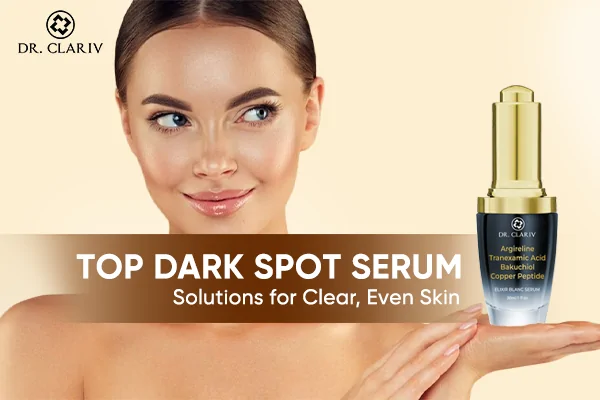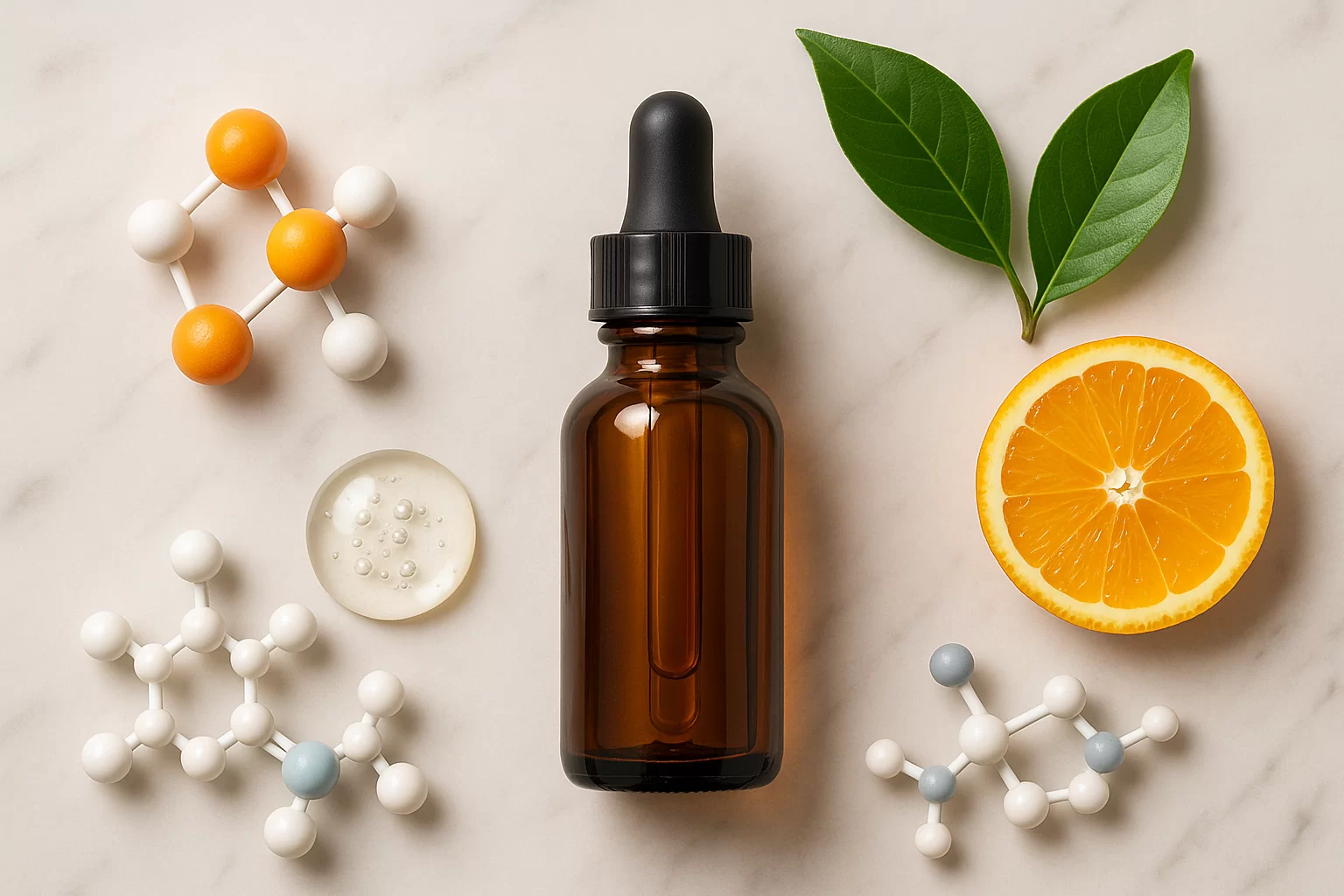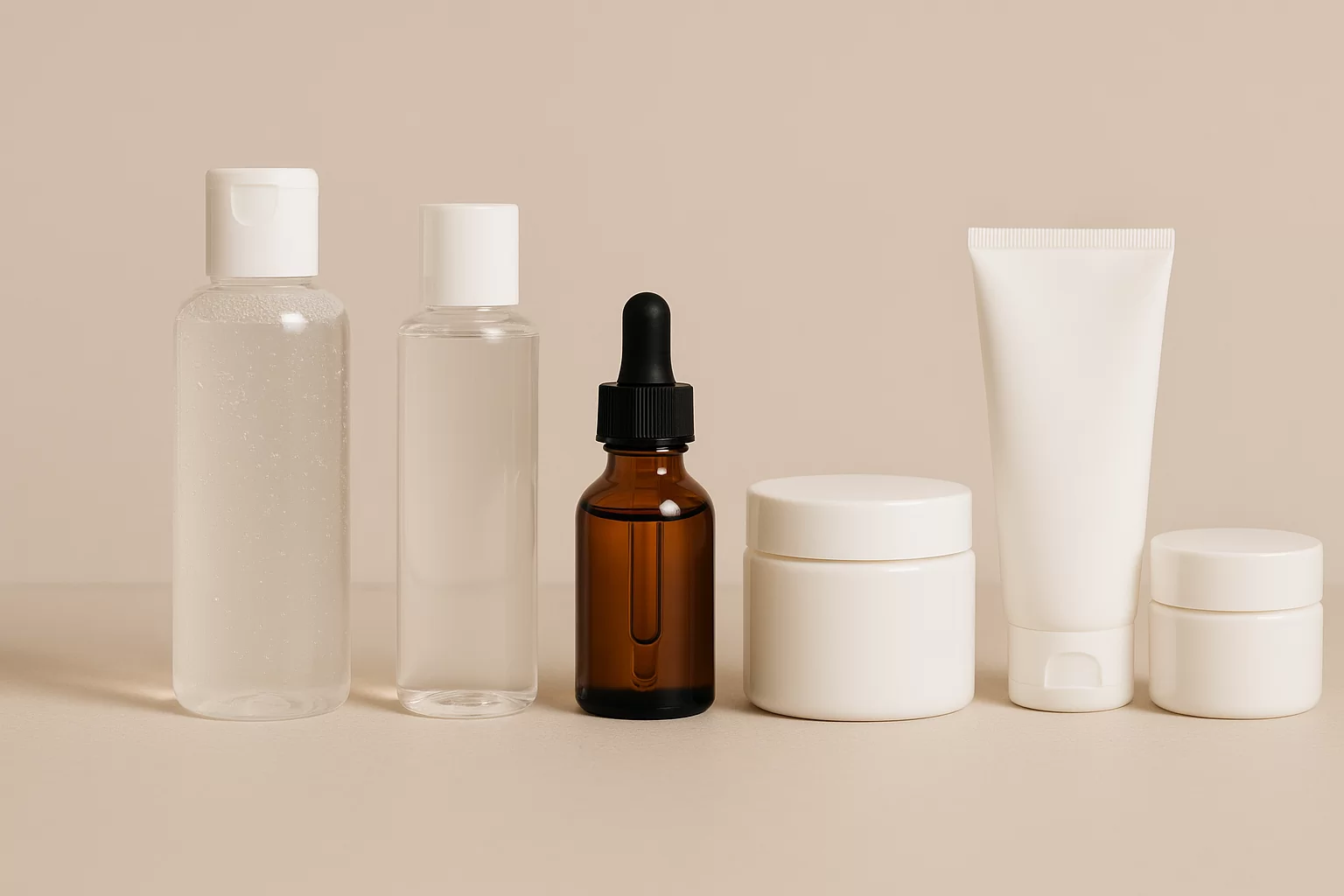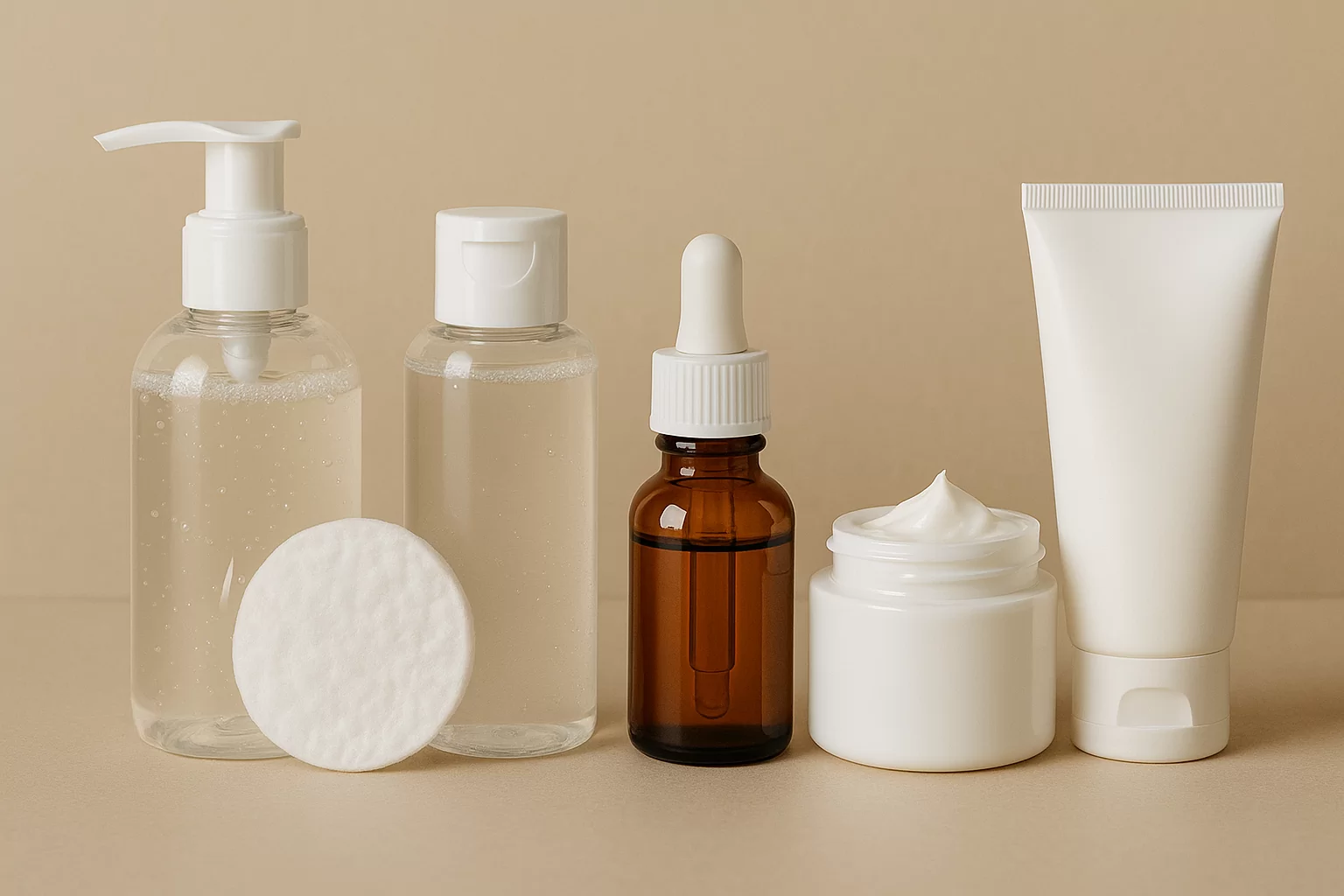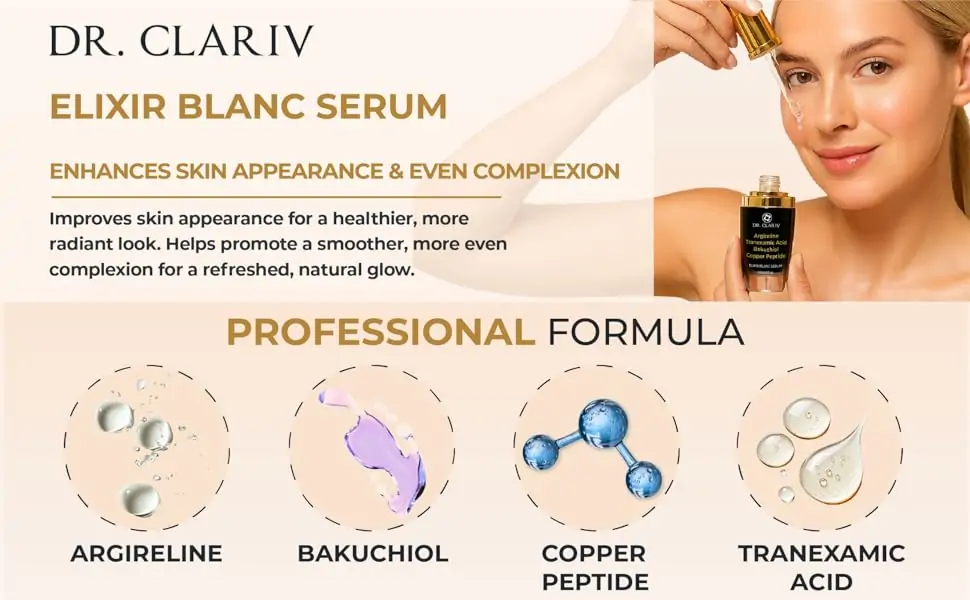BLOG, ELIXIR BLANC SERUM
Top Dark Spot Serum Solutions for Clear, Even Skin
Achieving a luminous, even-toned complexion often hinges on choosing the right dark spot serum, especially if you’re battling post-acne marks, melasma, or other forms of hyperpigmentation. A targeted dark spot serum can inhibit excess melanin production, fade stubborn discoloration, and help maintain a balanced tone across the face. Whether you have oily, acne-prone skin or experience sun-induced dark patches, specialized formulations exist to address your specific needs.
In this comprehensive guide, we’ll explore everything from the science behind a dark spot correcting serum to top product suggestions—tailored for skin types that range from oily and acne-prone to dull and hyperpigmented. We’ll also introduce DR. CLARIV’s Elixir Serum, which can complement any Top Dark Spot Serum Solutions for Clear, Even Skinregimen focused on fading dark spots.
What Is a Dark Spot Serum?
A dark spot serum (also known as a pigmentation-targeting treatment) is a lightweight, highly concentrated formula designed to target areas of uneven pigmentation—such as post-acne marks, age spots, and melasma. Unlike traditional moisturizers or creams, a dark spot serum delivers active agents like vitamin C, niacinamide, and specialized brightening complexes directly to the epidermal layers. This ensures deeper penetration and accelerated results compared to general skincare products.
When searching for a dark spot serum, look for formulas that combine multiple mechanisms—antioxidants to combat free radicals, exfoliating acids to remove surface melanin, and melanin-inhibiting agents (e.g., tranexamic acid) to block the synthesis of new dark patches. By understanding how a dark spot serum works at the molecular level, you’ll be better equipped to choose a solution that aligns with your skin’s unique needs and sensitivities.
A well-formulated dark spot serum offers several advantages over bulkier products:
-
Higher Potency of Actives: With a thinner base, serums house greater concentrations of brightening ingredients.
-
Rapid Absorption: The lighter consistency enables swift penetration, delivering active ingredients more effectively than heavier formulations.
-
Layering Capability: A dark spot serum can be easily incorporated under moisturizers and sunscreens without pilling or feeling greasy.
Whether you’re tackling post-inflammatory hyperpigmentation from acne scarring or age spots from years of sun exposure, integrating a dark spot serum into your routine can make a significant difference in how quickly and uniformly your skin clears.
Benefits of a Dark Spot Correcting Serum for Hyperpigmentation
A dark spot correcting serum takes a targeted approach by blending multiple known depigmenting agents—such as hydroquinone alternatives, peptides, and botanical extracts—into a cocktail designed to fade discoloration at its source. Unlike general brightening products that simply offer surface-level radiance, a dark spot correcting serum addresses the core mechanisms of pigmentation: melanin synthesis, inflammatory signaling, and cellular turnover. Below are core benefits of adding a dark spot correcting serum to your regimen:
-
Inhibits Melanin Production: Key active ingredients (e.g., tranexamic acid, kojic acid) interrupt tyrosinase activity, preventing excess melanin formation. A quality dark spot correcting serum often combines tyrosinase inhibitors with antioxidant-rich botanicals.
-
Accelerates Cellular Renewal: Gentle exfoliating acids—like glycolic or lactic acid—found in many dark spot correcting serum formulas speed up the removal of dead skin cells, revealing fresher, brighter skin beneath hyperpigmented patches.
-
Reduces Inflammation: Niacinamide and green tea extract, frequently included in a dark spot correcting serum, soothe redness and downregulate inflammatory cytokines, making them ideal for post-acne marks.
-
Provides Antioxidant Shield: Excess UV exposure and pollutants generate free radicals that worsen pigmentation. A dark spot correcting serum typically incorporates vitamin C or stabilized vitamin C derivatives to neutralize oxidative stress.
-
Enhances Overall Radiance: Beyond fading dark spots, this serum formulation often includes humectants—like hyaluronic acid—that maintain hydration, giving your skin a luminous, dewy finish.
For dry patches around post-acne spots, a dark spot correcting serum can deliver humectant-based hydration alongside active brighteners. If you have acne-prone or oily skin, opt for a dark spot correcting serum with oil-regulating ingredients (e.g., niacinamide, zinc PCA) to prevent excess sebum production while treating existing marks.
How a Dark Spot Correcting Glow Serum Enhances Radiance
When it comes to achieving an illuminated, dewy finish, a dark spot correcting glow serum stands out by blending exfoliating acids, melanin-inhibitors, and multi-layer humectants. This specialized formula not only fades dark patches but also confers an immediate “glow” effect by refining texture and imparting luminosity. Here’s what to expect from a well-formulated dark spot correcting glow serum:
-
Dual-Action Exfoliation and Brightening: Ingredients like glycolic acid or phytic acid gently resurface dead cells, while licorice root extract and tranexamic acid work synergistically to brighten underlying pigmentation. A dark spot correcting glow serum ensures that exfoliation does not leave the skin overly sensitive by balancing pH levels and incorporating soothing botanicals.
-
Hydration-Boosting Layers: To create that “lit-from-within” radiance, a dark spot correcting glow serum often infuses hyaluronic acid, glycerin, and panthenol. These humectants draw water into the epidermis, plumping fine lines and adding bounce—key for skin that looks dewy and healthy.
-
Antioxidant Support for Environmental Protection: Pollution and blue light can exacerbate existing dark spots. A dark spot correcting glow serum typically includes stabilized vitamin C, ferulic acid, or resveratrol to provide a robust antioxidant barrier against free radicals.
-
Subtle Luminescence: Some advanced dark spot correcting glow serum formulas incorporate light-reflecting microspheres or soft-focus pigments that create an immediate optical brightening effect, reducing the appearance of pigmentation instantly—while long-term actives work on underlying causes.
If you have oily or acne-prone skin, choose a dark spot correcting glow serum that is non-comedogenic and oil-free. This ensures the humectant-rich formula won’t exacerbate breakouts while still delivering that coveted glow. For dry or mature skin, a dark spot correcting glow serum enriched with ceramides and botanical oils like squalane can maintain the moisture barrier and prevent any dryness from acid-based exfoliation.
Choosing the Right Dark Spot Corrector Serum for Your Skin
Selecting a dark spot corrector serum requires understanding your unique skin profile—whether you’re oily, sensitive, post-acne, or battling sun-induced discoloration. Below are key factors to consider when browsing dark spot corrector serum options:
-
Ingredient Profile:
-
For acne scars: Look for niacinamide, azelaic acid, and tranexamic acid in your dark spot corrector serum. These ingredients reduce inflammation and hinder melanin synthesis without clogging pores.
-
For melasma or hormonal hyperpigmentation: A dark spot corrector serum with kojic acid, licorice root extract, and alpha arbutin can improve tone by blocking tyrosinase.
-
For sunspots and age spots: Opt for a dark spot corrector serum that contains vitamin C in a stable form (e.g., ascorbyl glucoside) alongside peptide complexes to support collagen.
-
-
Texture and Formulation:
-
Lightweight, water-based gels or watery emulsions are ideal if you’re prone to breakouts. A gel-like dark spot corrector serum that absorbs instantly prevents pore congestion.
-
If you have dry or mature skin, a richer, milky dark spot corrector serum with additional emollients like squalane and ceramides can counteract any dryness from active brighteners.
-
-
pH Level and Delivery System:
-
Many acids (glycolic, lactic) require a pH between 3.5–4.5 for efficacy. Ensure your dark spot corrector serum labels provide pH information or mention “pH-adjusted.”
-
Advanced delivery systems—like liposomal encapsulation—protect sensitive brighteners from oxidation and ensure deeper penetration. A dark spot corrector serum using liposomes or microsponge technology often yields more noticeable results.
-
-
Safety and Sensitivity:
-
Patch-test any dark spot corrector serum for 48 hours on a small area, especially if it contains potent acids or high vitamin C concentrations.
-
If you have sensitive or rosacea-prone skin, avoid formulas with alcohol, fragrance, or high percentages of AHAs. Instead, choose a dark spot corrector serum with soothing chamomile, aloe vera, or centella asiatica.
-
-
SPF Compatibility:
-
Any dark spot corrector serum containing exfoliating acids or retinoids can increase sun sensitivity. Always layer a broad-spectrum sunscreen (SPF 30 or higher) on top of your dark spot corrector serum to prevent new pigmentation and protect skin integrity.
-
By matching your skin’s specific concerns—acne scarring, melasma, or sunspots—with the right active profile in a dark spot corrector serum, you’ll optimize results while minimizing irritation.
Why You Need a Serum for Dark Spots in Your Routine
If you’ve ever wondered whether to incorporate a serum for dark spots alongside your moisturizer or spot treatment, consider the advantages:
-
Concentrated Active Delivery: A serum for dark spots typically contains higher percentages of brightening agents (e.g., 2%–4% niacinamide, 10%–20% vitamin C) than toners or moisturizers, ensuring more potent results.
-
Layering Versatility: Because a serum for dark spots has a lightweight consistency, it can be layered under various products—whether your morning routine calls for a vitamin-rich moisturizer or your nighttime routine includes heavier occlusives.
-
Preventive Maintenance: Regular use of a serum for dark spots helps prevent new melanin formation by actively inhibiting tyrosinase. Over time, consistent application reduces the need for more aggressive procedures like peels or lasers.
-
Synergistic Formulations: Many serum for dark spots options combine hydration and barrier-supporting ingredients—such as hyaluronic acid and ceramides—so that while you fade pigmentation, you also maintain optimal moisture levels.
Here’s how to integrate a serum for dark spots into your daily regimen:
-
Morning Application: After cleansing and toning, apply a few drops of your serum for dark spots onto slightly damp skin. Follow with a hydrating moisturizer and broad-spectrum SPF.
-
Evening Layering: If your serum for dark spots contains alpha or beta hydroxy acids, use it in the evening to allow deeper exfoliation and renewal overnight. Pair with a gentle peptide or ceramide-based night cream to support barrier repair.
-
Spot Treatment vs. All-Over Application: Some serum for dark spots products are formulated as spot treatments (higher concentration in a small applicator), while others are meant for full-face application. Choose based on your pigmentation pattern—spot serums if you have isolated marks, or all-over serums if you have widespread dullness or melasma.
By adding a serum for dark spots to both your morning and evening routines—with careful layering and sun protection—you create a continuous cycle of melanin suppression and cell turnover, yielding clearer, more radiant skin.
Intensive Fade Solutions for Stubborn Discoloration
For deeper, more resilient pigmentation—such as long-standing sunspots or hormonal melasma—an intensive fade formula blends potent, multi-layered actives:
-
High-Potency Brighteners: Ingredients like 2%–3% tranexamic acid, 5% niacinamide, and 2%–4% glutathione target various stages of melanin production and transfer.
-
Stronger Exfoliation: Formulas with 10%–12% mandelic or lactic acid remove thicker layers of pigmented cells, while Citric Acid balances pH.
-
Deep-Penetration Delivery: Liposomal encapsulation or nano-sized spheres ensure actives reach deeper epidermal layers.
-
Barrier Restoration: Since aggressive acids can be drying, these treatments often include ceramides, squalane, and cholesterol to reinforce the lipid barrier.
-
Antioxidant & Anti-Inflammatory Complex: High concentrations of stabilized vitamin C, vitamin E, and botanical anti-inflammatories (bisabolol, centella asiatica) help prevent rebound pigmentation.
Use these intensive formulas at night—after cleansing—to allow overnight renewal. Apply only 3-4 times weekly, under a rich, barrier-supporting cream. In the morning, always follow with SPF 50 to prevent relapse. Over 8–12 weeks, this powerful approach can significantly fade even the most entrenched spots.
Key Ingredients to Look for in Dark Spot Serums
When shopping for a dark spot serum, dissect the ingredient list to ensure you’re getting clinically proven actives. Below are some of the most potent ingredients for targeted hyperpigmentation treatment:
-
Vitamin C (L-Ascorbic Acid or Stable Derivatives): A potent antioxidant that brightens, stimulates collagen, and protects against UV- and pollution-induced free radicals. In a dark spot correcting glow serum, vitamin C also enhances immediate radiance.
-
Niacinamide: This vitamin B3 derivative prevents the transfer of melanosomes to keratinocytes, reducing the appearance of dark spots. A serum for dark spots with 5%–10% niacinamide also regulates sebum production, making it ideal for those with oilier complexions.
-
Tranexamic Acid: Clinically proven to treat melasma and stubborn discoloration, tranexamic acid is a staple in a faded serum for dark spots & discoloration, often used alongside niacinamide for synergistic action.
-
Alpha Arbutin and Beta Arbutin: Derived from the bearberry plant, arbutin inhibits tyrosinase without irritating. A dark spot corrector serum with 2%–3% alpha arbutin is suitable for sensitive or post-acne skin.
-
Licorice Root Extract: Contains glabridin, which helps even tone and calm inflammation. When paired with tranexamic acid, a dark spot correcting serum achieves balanced brightening.
-
Azelaic Acid: Effective for post-inflammatory hyperpigmentation, azelaic acid also fights acne-causing bacteria. A dark spot corrector serum featuring 10%–15% azelaic acid can address both acne and the lingering dark spots it creates.
-
Exfoliating Acids (Glycolic, Lactic, or Mandelic): These AHAs remove surface layers of pigmented cells. In a dark spot correcting glow serum, low concentrations (5%–10%) ensure gentler exfoliation.
-
Kojic Acid: A mild tyrosinase inhibitor that brightens without the harsh side effects of stronger bleaching agents. A dark spot corrector serum with 1%–2% kojic acid is effective for superficial discoloration.
-
Peptides and Growth Factors: Some advanced dark spot serum formulations include peptides like Matrixyl or copper peptides to support overall skin repair and texture improvement while brightening.
By prioritizing these scientifically proven ingredients in your dark spot serum, you ensure you’re tackling multiple mechanisms of pigmentation—melanin production, inflammatory signaling, and surface shedding—thus maximizing your chances of clear, even skin.
How to Use Dark Spot Serums for Best Results
Incorporating a dark spot serum into your skincare ritual requires consistent application and proper layering to achieve optimal results. Follow these guidelines:
-
Cleanse Gently: Start with a mild, pH-balanced cleanser—especially important if you’re prone to acne or have sensitive skin. A foaming or gel-based cleanser ensures that all traces of makeup, oil, and pollutants are removed before you apply your dark spot serum.
-
Tone or Prep (Optional): If you use a hydrating toner or essence, allow it to fully absorb. Avoid harsh toners with alcohol or excessive exfoliants within the same routine as your dark spot correcting serum, as this can increase sensitivity.
-
Apply the Serum:
-
Dispense 3–4 drops of your dark spot correcting serum onto slightly damp skin.
-
Gently press and pat into areas of pigmentation, such as post-acne scars or melasma patches, blending outward to avoid abrupt lines of demarcation.
-
For a serum for dark spots, you may choose to apply all over the face if you have widespread hyperpigmentation; otherwise, focus on isolated spots.
-
-
Allow Absorption Time: Give your dark spot correcting glow serum at least 60 seconds to fully penetrate before layering additional products.
-
Layer Moisturizer: Follow with a suitable moisturizer that complements your serum’s actives. If using a dark spot corrector serum with strong exfoliants, choose a moisturizer with ceramides or fatty acids to reinforce the skin barrier.
-
Apply Sunscreen (Morning Only): A broad-spectrum SPF 30 or higher is essential after applying any dark spot serum, particularly those containing AHAs or AHA derivatives. Sunscreen prevents dark spots from becoming darker and protects the skin while brightening agents work.
-
Frequency of Use:
-
Start with once daily—preferably at night—to allow your dark spot serum to work overnight without UV interference.
-
If your dark spot serum is gentle (e.g., niacinamide-based), you can progress to morning and evening applications—always paired with SPF during the day.
-
For formulations that include retinol or potent acids, limit to 2–3 nights per week initially, gradually increasing frequency as tolerated.
-
By adhering to this regimen consistently—morning and/or night depending on product potency—you’ll give your dark spot serum the ideal environment to diminish pigmentation over time.
Recommendations for Oily, Acne-Prone, and Dull Skin
Finding a dark spot serum that caters specifically to oily or acne-prone skin, as well as addressing general dullness or hyperpigmentation, requires a nuanced understanding of ingredient synergy. The following suggestions highlight products and formulations optimized for various concerns:
1. For Oily and Acne-Prone Skin
-
Key Ingredients: 5%–10% niacinamide, 10% azelaic acid, 1%–2% kojic acid, 1% tranexamic acid.
-
Recommended Format: Lightweight, water-based gel or watery emulsion that absorbs rapidly without clogging pores.
-
Product Suggestion:
-
DR. CLARIV’s Elixir Serum (if formulated to include niacinamide and tranexamic acid) can provide a hydrating, oil-free base while delivering potent melanin inhibitors.
-
A dedicated dark spot serum featuring 10%–15% azelaic acid: Azelaic acid offers dual action against acne-causing bacteria and post-inflammatory hyperpigmentation, making it ideal for those dealing with active breakouts and dark spots.
-
-
Routine Tip: Apply your acidic dark spot correcting serum at night, followed by a non-comedogenic, gel-based moisturizer. In the morning, cleanse and reapply a lightweight serum for dark spots that contains niacinamide, then finish with an oil-free SPF.
2. For Skin with Post-Acne Marks and Hyperpigmentation
-
Key Ingredients: 2%–4% alpha arbutin, 3%–5% niacinamide, 1%–2% licorice extract, 0.5%–1% retinol or bakuchiol.
-
Recommended Format: Non-greasy, creamy-serum hybrid that allows deeper penetration and longer contact time on post-acne spots.
-
Product Suggestion:
-
A dark spot correcting glow serum combining alpha arbutin and niacinamide: This pairing inhibits new melanin formation while evening existing marks.
-
DR. CLARIV’s Elixir Serum, which may include argireline and copper peptides for added repair—coupled with brightening agents—can be layered under a dedicated dark spot corrector serum containing vitamin C derivatives for enhanced results.
-
-
Routine Tip: Use a gentle exfoliating toner 1–2 times per week to remove superficial dead cells. On nights when you haven’t exfoliated, apply your faded serum for dark spots & discoloration containing tranexamic acid and alpha arbutin. Follow with a restorative cream that contains ceramides and peptides.
3. For Dull, Sun-Damaged, or Melasma-Prone Skin
-
Key Ingredients: 10%–20% stable vitamin C (e.g., ascorbic acid or MAP), 2%–4% tranexamic acid, 3%–5% ferulic acid, 2%–3% glutathione.
-
Recommended Format: Antioxidant-rich, oil-in-water emulsions or milky textures that protect and brighten simultaneously.
-
Product Suggestion:
-
A potent dark spot serum featuring a stable vitamin C derivative, with tranexamic acid to tackle melasma. Pair this with a dark spot correcting glow serum that includes ferulic acid to boost antioxidant potency.
-
DR. CLARIV’s Elixir Serum can serve as a supplementary product if it includes bakuchiol (mild retinol alternative) and tranexamic acid, offering night-time support for melanin inhibition.
-
-
Routine Tip: In the morning, cleanse, apply your antioxidant-heavy vitamin C dark spot serum, layer with a nourishing moisturizer, and finish with broad-spectrum SPF. At night, use your dark spot corrector serum with tranexamic acid, followed by a richer night cream containing peptides and hyaluronic acid for barrier support.
By tailoring your dark spot serum selections to your skin type—oily, acne-prone, or dull/sun-damaged—you’ll maximize efficacy and minimize adverse reactions, leading to a clearer, more even complexion.
Introducing DR. CLARIV and Elixir Serum
While many brands specialize in single-issue brightening, DR. CLARIV’s Elixir Serum stands out by offering a multifunctional approach suitable for a wide array of pigmentation concerns. Engineered for sensitive, acne-prone, and mature skin, Elixir Serum combines cutting-edge research with potent natural extracts to tackle dark spots at the source. Key features include:
-
Argireline Peptide: Targets dynamic expression lines to prevent early signs of aging—ensuring that your dark spot serum routine doubles as an anti-wrinkle strategy.
-
Bakuchiol (Retinol Alternative): Delivers retinol-equivalent benefits—stimulating collagen and normalizing cell turnover—without the typical irritation, making it compatible with a dark spot correcting glow serum routine.
-
Copper Peptides: Support natural wound healing and collagen synthesis, which is especially beneficial for post-acne marks. When paired with dedicated dark spot corrector serum products, these peptides enhance overall skin repair and resilience.
-
Tranexamic Acid: Inhibits tyrosinase activity to reduce melanin synthesis—an essential component in any faded serum for dark spots & discoloration protocol.
-
Hydrating Base: Featuring hyaluronic acid and glycerin, Elixir Serum provides hydration to ensure barrier integrity, helping to mitigate dryness from potent brightening agents.
Incorporating DR. CLARIV’s Elixir Serum as a complementary step alongside your primary dark spot serum offers a layered defense: brightening, anti-aging, and barrier restoration. This holistic approach means you treat existing discoloration while preventing future pigmentation and maintaining skin health.
Proactive Measures to Prevent New Dark Spots
Even the best dark spot correcting serum can only work on existing pigmentation; safeguarding your skin from UV and environmental triggers is crucial to prevent new spots from forming. Implement these proactive habits alongside your serum for dark spots routine:
-
Consistent Sun Protection:
-
Use a broad-spectrum SPF 30 or higher daily—regardless of weather.
-
Reapply every two hours when outdoors, especially if swimming or sweating.
-
Consider physical blockers (zinc oxide, titanium dioxide) in your sunscreen to avoid chemical irritation that could exacerbate pigmentation.
-
-
Wear Protective Accessories:
-
Wide-brimmed hats shield your face from overhead UV rays.
-
UV-protective sunglasses guard the delicate undereye area—often prone to sun-induced dark circles.
-
Lightweight, UV-resistant scarves or clothing can further limit exposure during peak sunshine hours.
-
-
Limit Direct Sun Exposure During Peak Hours:
-
The strongest UV radiation occurs between 10 AM and 2 PM. Schedule outdoor activities in the early morning or late afternoon whenever possible.
-
By adhering to a comprehensive sun-protection plan—paired with your dark spot serum and DR. CLARIV’s Elixir Serum—you’re not only fading existing discoloration but also significantly reducing the risk of new spots.
Frequently Asked Questions About Dark Spot Serums
Q: How quickly will I see improvements?
Most users notice a significant reduction in mild-to-moderate dark marks within 4–6 weeks of consistent application—whether using a glow-boosting elixir or a stronger fade concentrate. More resistant melasma or deep sunspots may take 8–12 weeks. Consistent sun protection is essential to prevent setbacks.
Q: Can I layer multiple fade treatments?
Yes—but do so strategically. For example, apply a vitamin C–based glow serum in the morning under SPF, then use a niacinamide/tranexamic acid corrective formula at night. If you want to incorporate AHAs or retinoid alternatives, alternate nights to avoid over-exfoliation.
Q: Are these treatments safe during pregnancy?
Avoid hydroquinone, high-strength retinoids, and professional peels while pregnant. Stick to gentler agents—niacinamide, alpha arbutin, or licorice extract—after checking with your OB-GYN.
Q: How do I tell melasma apart from acne scarring?
-
Melasma presents as symmetrical patches (cheeks, forehead, upper lip), often hormonal or sun-triggered. Treat with a potent fade concentrate featuring tranexamic acid and diligent SPF.
-
Post-Inflammatory Hyperpigmentation (Acne Scars): Irregular, spotty marks where pimples once were. A corrective serum with azelaic acid and alpha arbutin effectively fades these over 6–8 weeks.
Q: Will my spots return if I stop treatment?
Possibly—especially if you discontinue sun protection and barrier support (e.g., DR. CLARIV’s Elixir Serum). Maintain a gentle maintenance regimen (low-strength brightener) 2–3 times per week and continue broad-spectrum SPF daily to keep new spots at bay.
Q: Are these treatments suitable for men?
Absolutely. Men can benefit from depigmenting ingredients like tranexamic acid, niacinamide, and azelaic acid. A simple AM routine—apply a glow concentrate, follow with an oil-free moisturizer and mineral SPF—paired with a nightly corrective serum helps fade shaving-related marks or sunspots.
Before & After Stories
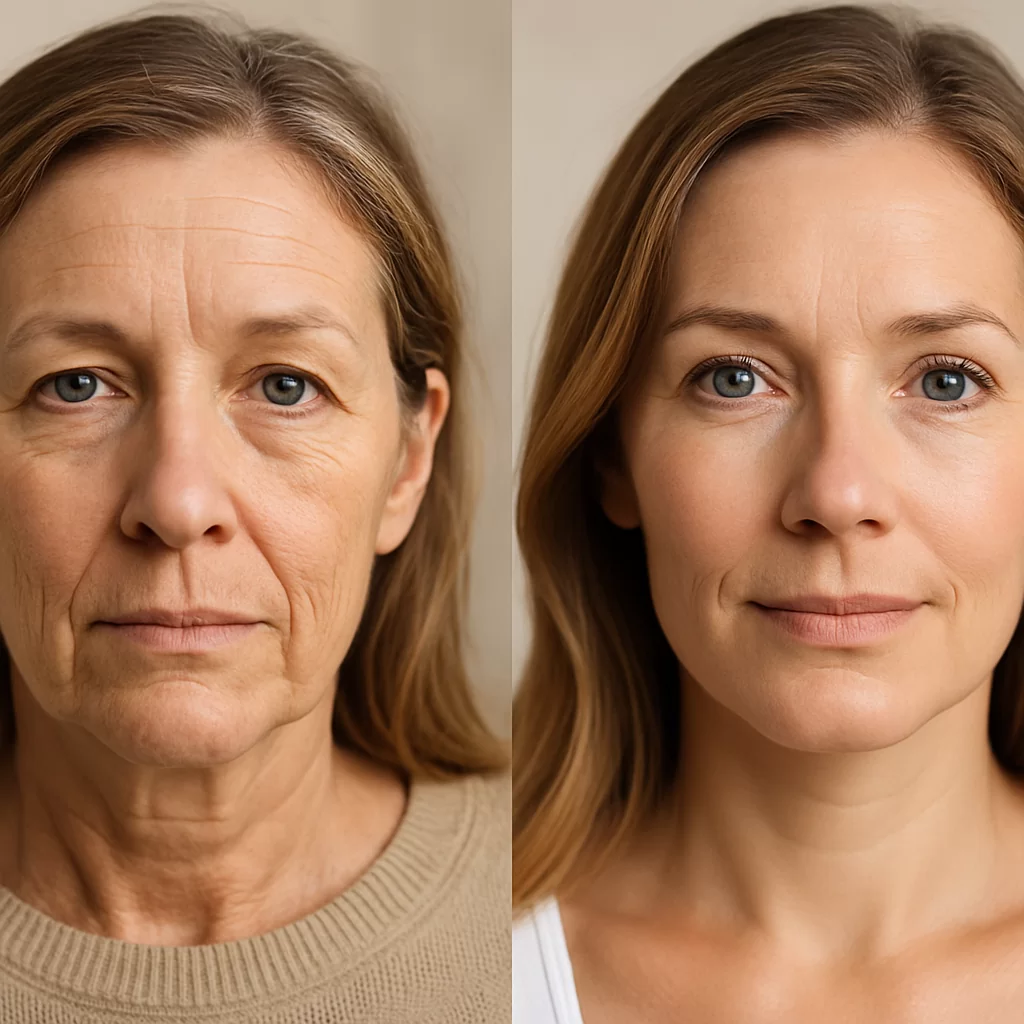 |
⭐⭐⭐⭐⭐“I was skeptical about peptides, but after using Elixir Blanc Serum nightly, my crow’s feet have visibly diminished. The copper peptides really deliver on their firming promise—my skin feels more elastic, and I’ve even noticed fewer dark spots thanks to the tranexamic acid.” — Sophia L., 58, Chicago |
Building a Harmonized Anti-Aging and Brightening Routine
If you’re simultaneously addressing fine lines and dark spots, consider combining your dark spot serum with anti-aging treatments for a comprehensive regimen. Follow these layering recommendations:
-
Cleanser: Gentle, pH-balanced—aim for a formula with ceramides or hydrating amino acids. This prepares skin for subsequent actives.
-
Toner or Essence (Optional): pH-adjusted, alcohol-free. If you use AHAs, skip harsh toners on the same day to avoid over-exfoliation.
-
Anti-Aging Serum: If you’re using a retinol or bakuchiol-based anti-aging serum, apply it first at night (after cleansing), then follow with your dark spot correcting glow serum if you’re addressing discoloration simultaneously.
-
Dark Spot Serum:
-
Morning: After cleansing, apply your vitamin C-based dark spot correcting serum (e.g., 15% L-ascorbic acid or MAP).
-
Evening: Use your faded serum for dark spots & discoloration with tranexamic acid or alpha arbutin.
-
-
Moisturizer: Select a formula rich in ceramides, fatty acids, and peptides to support barrier repair—especially crucial if you’re layering multiple actives.
-
Eye Cream: Incorporate an eye cream with caffeine or peptides to address fine lines and dark circles around the eyes.
-
Sunscreen (Morning Only): A broad-spectrum SPF 30 or higher—ideally with physical blockers—to guard against UV-induced pigmentation and photoaging.
By following a structured routine—alternating potent actives and ensuring ample hydration—you’ll accelerate both wrinkle smoothing and hyperpigmentation correction.
Professional Procedures to Complement Your At-Home Regimen
Even the most potent at-home formula can be accelerated by in-office treatments. Consider:
-
Chemical Peels (Glycolic, Mandelic, TCA):
-
Superficial glycolic peels (20%–30%) remove surface pigment and prime skin for deeper penetration of your corrective formula.
-
Mandelic peels (5%–10%) are gentler, ideal for sensitive or acne-prone skin, enhancing results from a glow-boosting concentrate.
-
TCA peels (10%–15%) can tackle deep-set melasma or sunspots, giving a significant push to your fade efforts.
-
-
Microneedling:
-
Tiny microchannels allow your corrective active to penetrate more deeply.
-
Immediately after the procedure, apply a hydrating, antioxidant-rich brightener (e.g., MAP or niacinamide) to soothe inflammation and maximize fade.
-
Schedule sessions every 4–6 weeks, continuing your at-home routine between visits.
-
-
Laser & IPL Treatments:
-
Q-switched or picosecond lasers break up melanin into fragments the body can clear.
-
Follow each session with a fade concentrate (2% tranexamic acid) and barrier-repair cream to prevent rebound pigmentation.
-
Typically, 2–3 sessions spaced 6–8 weeks apart yield substantial, long-term improvements.
-
-
Microdermabrasion:
-
Mechanical exfoliation sloughs off the top pigmented layer, providing an immediate tone boost.
-
After treatment, apply your glow-elixir or fade concentrate to lock in potent brighteners for faster fade.
-
-
LED Phototherapy:
-
Red light calms inflammation and promotes collagen, helping your skin better tolerate higher-strength fade treatments.
-
Blue light can manage mild acne when paired with an anti-bacterial, anti-pigment formula—ideal if post-acne marks linger.
-
By combining these professional services with your at-home routine—anchored by an effective brightening serum—you’ll achieve more dramatic, long-lasting results.
Final Thoughts on Dark Spot Serums
Choose the Right Formula:
For full-face maintenance and spot prevention, a versatile brightening serum with niacinamide, alpha arbutin, and tranexamic acid is ideal.
For targeted correction of stubborn marks, a higher-strength corrective concentrate (with azelaic acid or kojic acid) provides more intensive fade.
For that “lit from within” effect plus ongoing pigment suppression, a glow-infusing treatment with mild acids, humectants, and optical brighteners is perfect.
For pinpoint accuracy on isolated lesions, a thicker spot-correcting formula with deep-penetrating delivery technology yields the best results.
For intensive, long-term clearance of deep-set discoloration, a high-potency fade concentrate (with tranexamic acid, niacinamide, and stronger acids) is unmatched.
Stay Consistent:
Whether you’re using a glow-boosting elixir each morning or a corrective serum at night, daily (or nightly) commitment is key. Most users see noticeable changes within 8–12 weeks.
Document your progress with biweekly photos in consistent lighting to track subtle shifts.
Sun Protection Is Non-Negotiable:
Applying SPF 30+ (preferably mineral) each morning is critical. Regardless of the potencies in your fade formula, UV exposure can undo progress and deepen existing spots.
Combine with Professional Care:
If at-home treatments plateau, partner them with in-office peels, microneedling, or laser sessions—always following up with your chosen brightening serum to stabilize and enhance results.
Customize to Your Skin:
Oily/Acne-Prone: Lean on lightweight glow elixirs and corrective serums with azelaic or salicylic acid.
Dry/Mature: Embrace hydrating, peptide-infused brighteners and supportive barrier serums like DR. CLARIV’s Elixir Serum.
Sensitive/Reactive: Prioritize soothing formulas with niacinamide, mandelic acid, and centella asiatica to fade spots without flaring.
By combining a well-chosen brightening treatment, consistent sun protection, and supportive barrier serums—along with occasional professional treatments—you’ll craft a comprehensive strategy that effectively fades dark spots and elevates overall skin health. Embrace the process with patience, and let your complexion reveal its most radiant self.

